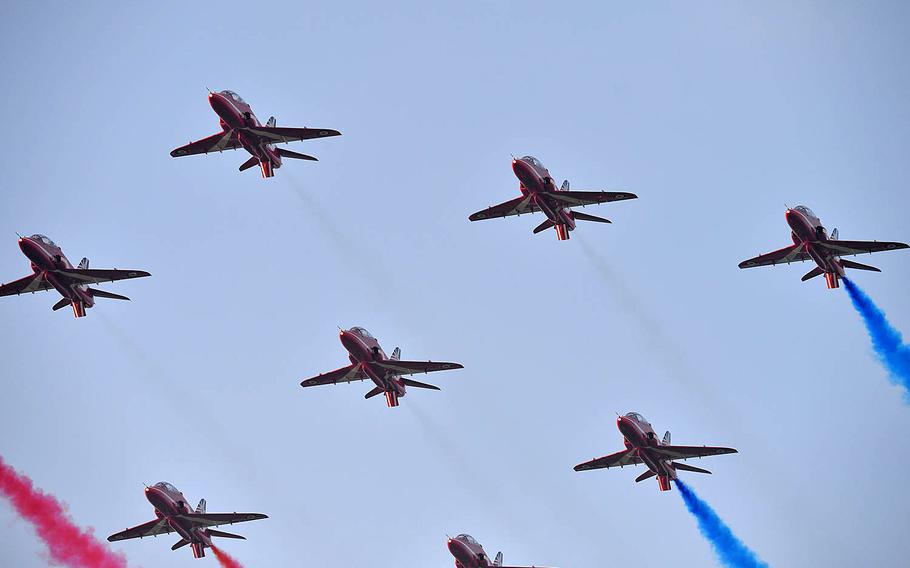
The Royal Air Force's Red Arrow's aerobatic display team flies past the site of the NATO summit in Newport, Wales, Friday, Sept. 5, 2014. They were the last group of jets participating in the flyby that included planes from various NATO members including two U.S. Air Force F-15Cs. The two-day NATO summit wrapped up on Friday. (Michael Abrams/Stars and Stripes)
NATO leaders agreed Friday to position several thousand troops at military bases in eastern Europe to shore up alliance defenses in response to Russia’s incursions in Ukraine.
Among the steps agreed by leaders of the alliance’s 28 member nations during a two-day summit in Wales: NATO will establish a new command and control headquarters in the region, build a “spearhead” rapid reaction force and take up residence at a series of “reception” bases where equipment also can be placed in advance.
“This decision sends a clear message: NATO protects all allies, at all times,” NATO Secretary General Anders Fogh Rasmussen said as the summit drew to a close. “And it sends a clear message to any potential aggressor: should you even think of attacking one ally, you will be facing the whole alliance.”
Since Russia annexed the Crimean peninsula from Ukraine earlier this year and subsequently backed pro-Russian separatists in eastern Ukraine, NATO member countries on or close to Russia’s borders have been seeking a commitment from the alliance that it will honor Article 5 in the NATO charter, which stipulates that an attack on one member will be met with a response by all.
As NATO members wrapped up their summit on Friday, Ukraine’s President Petro Poroshenko — who also attended the conference — announced that a cease-fire had been negotiated with the Russian-backed rebels in the east of the country. The 12-point deal, which would end the four-month conflict, goes into effect Friday evening, Poroshenko told reporters.
The agreement includes the release of all prisoners and greater autonomy for Ukraine’s Russian-speaking eastern regions, he said.
NATO currently maintains a small headquarters in Poland, which will now be increased to play a key role in planning and coordinating collective defense activities in the Baltics and with other eastern European allies, according to a NATO official.
For weeks, NATO officials have stated that the alliance would be beefing up its presence in the east with a new Readiness Action Plan, and the measures taken on Friday did not come as a surprise. It remains unclear how many troops will be positioned in the region, but Rasmussen said the alliance’s new spearhead force would involve several thousand ground troops.
NATO military personnel also would be required to man various bases in the east, where equipment will be stored, but on a rotational basis. Rasmussen did not say where those bases would be, but Poland, the Baltic nations and Romania all have volunteered to host.
Rasmussen stopped short of saying NATO would establish a permanent presence in the region, something Poland and the Baltic nations have sought. The idea of permanent bases is opposed by some members, including Germany, which view such action as a violation of NATO agreements with Russia. Although critics of that stance argue that Russia already violated the agreement by its actions in Ukraine.
Moscow has repeatedly dismissed claims that it represents a threat to any NATO member state.
NATO will “maintain continuous presence and activity in the air, on land and at sea in the eastern part of the Alliance, on a rotational basis,” Rasmussen said.
In addition, NATO will conduct more short notice exercises to improve its overall state of readiness.
NATO also approved 16 other priorities that take into account other threats, including cyber attacks, which Rasmussen said are now part of “NATO’s core task of collective defense.”
Gen. Philip Breedlove, NATO’s supreme allied commander, has said the alliance must take into account non-conventional threats in response to Russia’s application of so-called “hybrid warfare” tactics in Ukraine.
Additional priorities for NATO involve strengthening the military capabilities of non-member states such as Georgia and Moldova, which border Russia and like Ukraine were part of the Soviet Union, as well as Jordan, a country facing potential threat from the Islamic State group operating out of Syria and Iraq.
Meanwhile, NATO is ready to provide training support to Iraq’s security forces should Baghdad request such assistance, Rasmussen said.
“The security environment we face is more unpredictable than ever,” Rasmussen said. “ Russia is attacking Ukraine. Violent extremists are rising in the Middle East. Instability is growing in North Africa.”
“In these turbulent times, NATO must be prepared to undertake the full range of missions, and to defend allies against the full range of threats.”